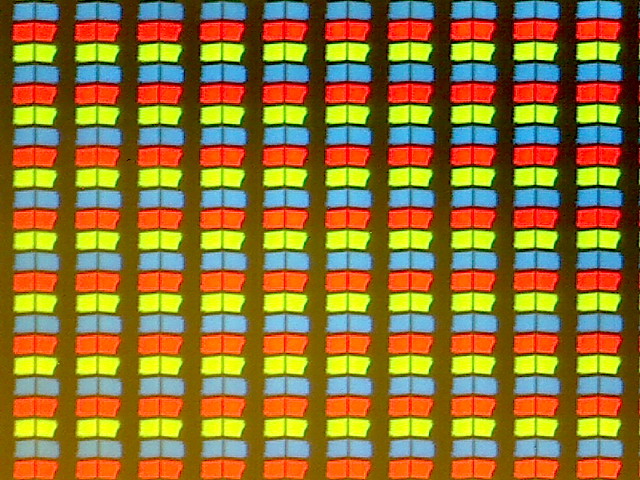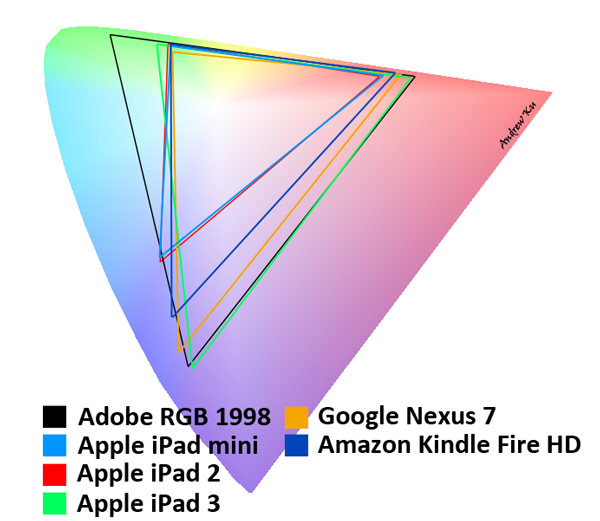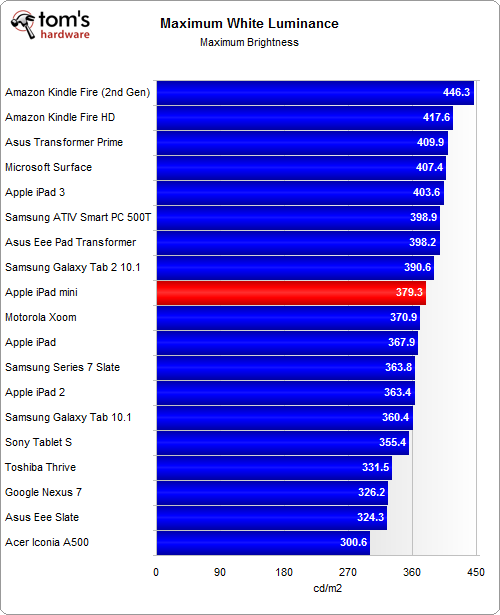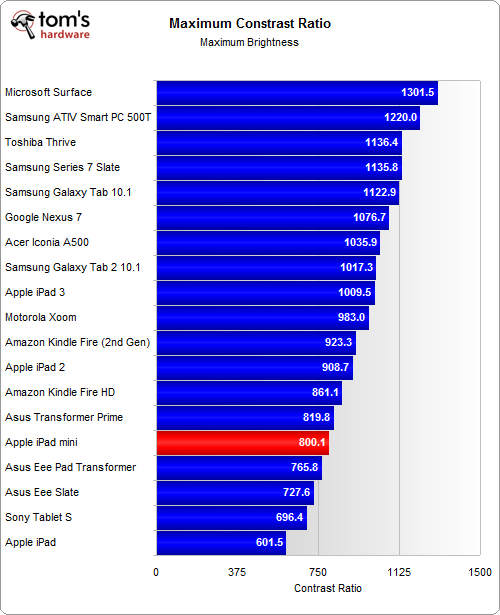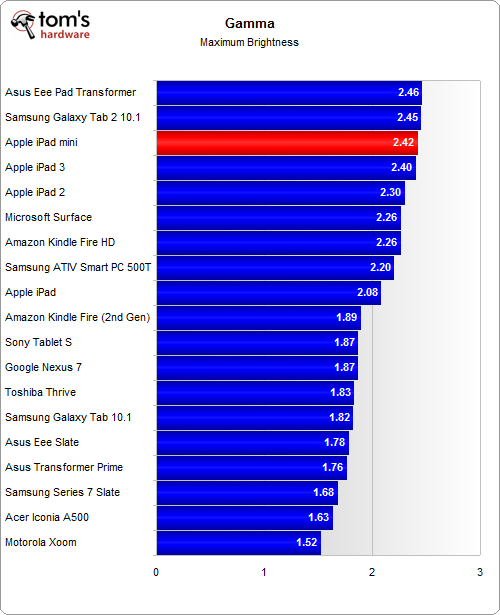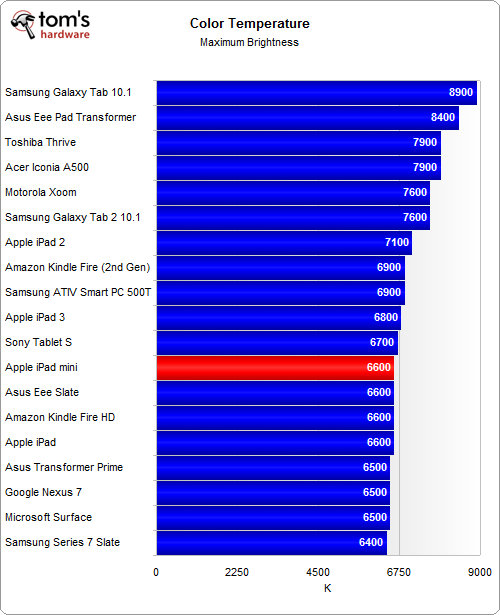Apple iPad Mini Review: Our New Favorite Size, But...That Price?
LCD Performance Analyzed
The iPad mini and iPad 2 both offer 1024x768 resolutions. However, the mini's screen is naturally smaller, which means its pixels are packed more tightly together. In fact, we know that the iPad Mini's LCD sports 163 pixels per inch (PPI), while the iPad 2 fits 132 PPI. As mentioned, both of those numbers are too low to qualify for Retina Display branding.
Rendering 48% of the AdobeRGB 1998 and 69% of the sRGB gamut, the iPad mini's color saturation is the same as the iPad 2.
If you map out the gamuts in 2D, the iPad mini basically overlaps the iPad 2. We're not necessarily bothered that Apple's display quality isn't any better on the mini than it was almost two years ago. The issue is that Apple's competition stepped up its game. The Nexus 7 and Kindle Fire HD both deliver more color saturation, the former by just 2%, but the latter by 11.
Two percent doesn't sound like much, but don't underestimate Google's Nexus.
In the video above, we've modeled the Nexus 7's (wire-frame) and iPad mini's (solid) gamuts in the Lab color space. It works like this: the top colors are highlights, or bright hues. As you go move down the vertical axis, the colors get darker. The gamut volume represents all the colors that a device can render.
We see that the iPad mini is able to render brighter reds, magentas, and a wider range of greens and cyans. The Nexus 7 sacrifices some range in green and yellow for brighter hues. The real difference is in the dark blue and magenta region. The Nexus 7 simply displays a huge range of hues that the iPad mini cannot.
Interestingly, the iPad mini reaches a somewhat higher brightness than the iPad 2, but suffers from slightly poorer contrast, since it struggles to render a true black. Yet, we can applaud Apple for getting color temperature much closer to the 6500 K standard. Gamma is still a bit high, but it's not terrible at 2.42.
Get Tom's Hardware's best news and in-depth reviews, straight to your inbox.
Amazon's Kindle Fire HD comes across amazingly well. It scores a really high gamut volume and comes close to the professionally-calibrated 6500 K and a 2.2 gamma standards.
Current page: LCD Performance Analyzed
Prev Page Web Browsing Tests Next Page Do Your Eyes Agree With Our Benchmarks?-
azathoth While the device is certainly nice, I don't like the fact that it has no support for MicroSD, and I would be unable to tinker around with it as I can for an Android based device.Reply
...And the price. I'm not going to give a second thought when I see a $200 tablet with removable storage versus $330 for 16GB of internal storage and no expansion options.
If the device was closer to say $260 for the 32GB version, or just included an option for removable storage... Then I would certainly see the iPad mini as being a viable option even for someone used to Android.
The main factors (in my opinion) for a great device are,
1: A good quality screen, it needs to have vibrant, accurate colours.
2: Even if during benchmarks the device is slow, if it FEELS snappy and quick, that's all that counts.
3: Removable storage for god sake, I know by practice apple enjoys their closed system, but COME ON!
4: It doesn't need to have some amazing 15 hour battery life, but I certainly don't want it to die on a full charge after a movie and a few youtube videos. -
hardcore_gamer I'm waiting for a 7 inch version of surface. It is the only productive tablet out there.Reply -
Darkerson Overpriced, but thats not really a surprise, since its an apple product. Sadly, people are eating them up regardless.Reply -
shikamaru31789 It's definitely overpriced, but I've come to expect that with Apple, you're mostly paying for a name and some unique styling with them. It has some features going for it, but I wouldn't buy one, not when there are several cheaper options in the mini tablet lineup. That's not stopping the legions of Apple sheep from buying it though.Reply -
Tomtompiper This is a blatant rip off of the Samsung Tab, I hope Samsung sue their ass off :kaola:Reply -
Jigo AzathothWhile the device is certainly nice, I don't like the fact that it has no support for MicroSD, and I would be unable to tinker around with it as I can for an Android based device....And the price. I'm not going to give a second thought when I see a $200 tablet with removable storage versus $330 for 16GB of internal storage and no expansion options.If the device was closer to say $260 for the 32GB version, or just included an option for removable storage... Then I would certainly see the iPad mini as being a viable option even for someone used to Android.The main factors (in my opinion) for a great device are, 1: A good quality screen, it needs to have vibrant, accurate colours.2: Even if during benchmarks the device is slow, if it FEELS snappy and quick, that's all that counts.3: Removable storage for god sake, I know by practice apple enjoys their closed system, but COME ON!4: It doesn't need to have some amazing 15 hour battery life, but I certainly don't want it to die on a full charge after a movie and a few youtube videos.Reply
you're right
I'm glad that i bought the Nexus7. 16GB is enough, and rootet i can plug in external device. And as for all my techy stuff, i doubt i've to send it in before the 2y warranty expires
